Mealybug
Scientific Name: Pseudococcidae (family)
Order & Family: Order: Hemiptera, Family: Pseudococcidae
Size: Typically 1-6 mm (0.04-0.24 inches) in length, though some species can be smaller or larger. The image suggests a magnified view of a small specimen, possibly 1-3 mm in actual size.

Natural Habitat
Mealybugs are widespread and can be found on a variety of plants, indoors and outdoors. They are common pests in greenhouses, on houseplants, in nurseries, and on tropical and subtropical fruit trees and ornamental plants. They tend to prefer warm, humid environments.
Diet & Feeding
Mealybugs are sap-feeders, meaning they feed on the sap of plants. They insert their stylets (modified mouthparts) into the plant's phloem to extract nutrients. This feeding can cause weakening, wilting, and distortion of plant growth. They excrete excess sugar as a sticky substance called honeydew.
Behavior Patterns
Mealybugs typically move slowly or are sessile once they find a feeding spot. They often aggregate in crevices or on the undersides of leaves. Females lay eggs in a cottony ovisac, which provides protection. During development, they go through several nymphal instars before maturing. Males are winged but short-lived and do not feed; their primary purpose is reproduction. Heavy infestations can lead to sooty mold growth due to honeydew excretion.
Risks & Benefits
Risks: Mealybugs are significant agricultural and horticultural pests. Heavy infestations can cause severe damage to plants, leading to stunted growth, leaf yellowing, wilting, premature leaf drop, and even plant death. The honeydew they secrete promotes the growth of sooty mold, which can block sunlight and reduce photosynthesis. Benefits: In certain ecosystems, mealybugs can serve as a food source for natural predators, such as ladybugs (e.g., *Cryptolaemus montrouzieri*), lacewings, and parasitic wasps, contributing to biological control.
Identified on: 9/4/2025